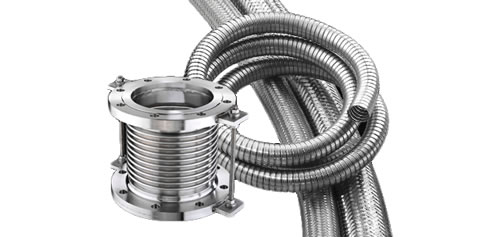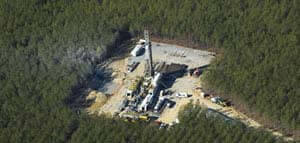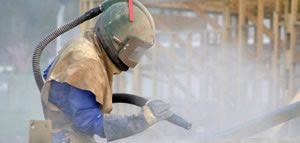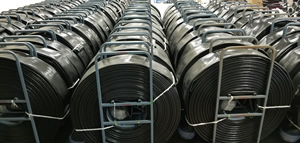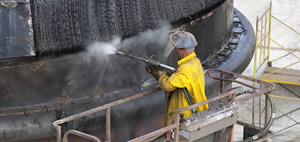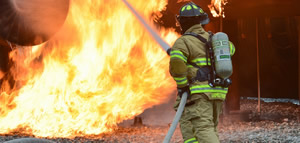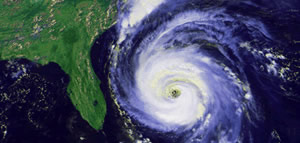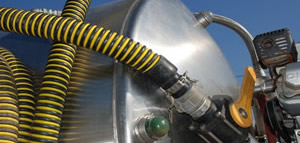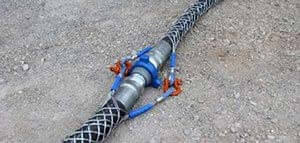Hose Test Methods
(Reprinted from RMA Hose Handbook IP-2 Sixth Edition 1996)
SAFETY WARNING: Testing can be dangerous and should be done only by trained personnel using proper tools and procedures. Failure to follow such procedures might result in damage to property and serious bodily injury.
The Rubber Manufacturers Association (RMA) recognizes, accepts and recommends the testing methods of the American Society for Testing and Materials (ASTM).
Unless otherwise specified, all hose tests are to be conducted in accordance with ASTM Method No. D-380 (latest revision). Where an ASTM D-380 test is not available, another test method should be selected and described in detail.
RMA participates with ASTM under the auspices of the American National Standards Institute (ANSI) in Technical Committee 45 (TC45) of The International Organization for Standardization (ISO) in developing both hose product and hose test method standards.
Many of the hose test method standards published by ISO duplicate or closely parallel those shown in ASTM D-380. Many are unique and, in those cases, the RMA may be able to provide the necessary test standard references which may be purchased from the American National Standards Institute (ANSI).
Hydrostatic Pressure Tests
Hydrostatic pressure tests are classified as follows:
b. Change in length test (elongationor contraction)
c. Change in outside diameter or circumference test
d. Warp test
e. Rise test
f. Twist test
g. Kink test
h. Volumetric expansion
Destructive Tests
Destructive tests are conducted on short specimens of hose, normally 18 inches (460mm) to 36 inches (915mm) in length and, as the name implies, the hose is destroyed in the performance of the test.
b. A hold test, when required, is a means of determining whether weakness will develop under a given pressure for a specified period of time.
Non-Destructive Tests
Non-destructive tests are conducted on a full length of a hose or hose assembly and are for the purpose of eliminating hose with defects which cannot be seen by visual examination or in order to determine certain characteristics of the hose while it is under internal pressure.
b. A hold test, when required, is a means of determining whether weakness will develop under a given pressure for a specified period of time. Percent length change elongation or contraction) is the difference between the length at 10 psi {0.069 MPa) (except wire braided or wire spiraled) and that at the proof pressure times 100 divided by the length at 10 psi (0.069 MPa). Elongation occurs if the length of the hose under the proof pressure is greater than at a pressure of 10 psi (0.069 MPa). Contraction occurs if the length at the proof pressure is less than at 10 psi (0.069 MPa).
In testing wire braided or spiraled hose, the proof pressure is applied and the length recorded. The pressure is then released and, at the end of 30 seconds, the length is measured; the measurement obtained is termed the "original length."
c. Percent change in outside diameter or circumference is the difference between the outside diameter or circumference at 10 psi (0.069 MPa) and that obtained under the proof pressure times 100 divided by the outside diameter or circumference at 10 psi (0.069 MPa). Expansion occurs if the measurement at the proof pressure is greater than at 10 psi (0.069 MPa). Contraction occurs if the measurement at the proof pressure is less than at 10 psi (0.069 MPa).
d. Warp is the deviation from the straight line drawn from fitting to fitting; the maximum deviation from this line is warp. First, a measurement is taken at 10 psi (0.069 MPa) and then again at the proof pressure. The difference between the two, in inches, is the warp. Normally this is a feature measured on woven jacket fire hose only.
e. Rise is a measure of the height a hose rises from the surface of the test table while under pressure. The difference between the rise at 10 psi (0.069 MPa) and at the proof pressure is reported to the nearest 0.25 inch (6.4 mm). Normally, this is a feature measured on woven jacket fire hose only.
f. Twist is a rotation of the free end of the hose while under pressure. A first reading is taken at 10 psi (0.069 MPa) and a second reading at proof pressure. The difference, in degrees, between the 10 psi (0.069 MPa) base and that at the proof pressure is the twist. Twist is reported as right twist (to tighten couplings) or left twist. Standing at the pressure inlet and looking toward the free end of a hose, a clockwise turning is right twist and counterclockwise is left twist.
g. Kink test is a measure of the ability of woven jacket hose to withstand a momentary pressure while the hose is bent back sharply on itself at a point approximately 18 inches (457mm) from one end. Test is made at pressures ranging from 62% of the proof pressure on sizes 3 inches (76 mm) and 3.5 inches (89 mm) to 87% on sizes under 3 inches (76 mm). This is a test applied to woven jacket fire hose only.
h.Volumetric expansion test is applicable only to specific types of hose, such as hydraulic or power steering hose, and is a measure of its volumetric expansion under ranges of internal pressure.
Design Considerations
In designing hose, it is customary to develop a design ratio, which is a ratio between the minimum burst and the maximum working pressure.Burst test data is compiled and the minimum value is established by accepted statistical techniques. This is done as a check on theoretical calculations, based on the strength of reinforcing materials and on the characteristics of the method of fabrication.
Minimum burst values are used as one factor in the establishment of a reasonable and safe maximum work pressure.
MAXIMUM WORKING PRESSURE IS ONE OF THE ESSENTIAL OPERATING CHARACTERISTICS THAT A HOSE USER MUST KNOW AND RESPECT TO ASSURE SATISFACTORY SERVICE AND OPTIMUM LIFE.
It should be noted that design ratios are dependent on more than the minimum burst. The hose technologist must anticipate natural decay in strength of reinforcing materials, and the accelerated decay induced by the anticipated environments in which the hose will be used and the dynamic situations that a hose might likely encounter in service.
Including all considerations, the following recommended design ratios are given for newly manufactured hose:
1. Water Hose up to 150 psi WP: 3:1
2. Hose for all other liquids, solid materials suspended in liquids or air, and water hose over 150 psi WP: 4:1
3. Hose for compressed air and other gases: 4:1
4. Hose for liquid media that immediately changes into gas under standard
atmospheric conditions: 5:1
5. Steam Hose: 10:1
Methods for Measuring Electrical Resistance of Hose
Method 1-Plug Method
Sample Preparation:
1. Cut a 24 inch (610mm) sample from the length of hose to be tested unless
the size and length of the hose is such that it is necessary to test the
entire length.
2. Buff both the tube and cover for 1.5 inch (38 mm) on each end with 120
grit emery paper.
3. Insert either polished steel or copper plugs having diameters equal to
the I.D. of the hose into each end for a distance of one inch (25mm).
4. Clamp the plugs in the hose with a polished 0.500 inch (12.7mm) reusable
and clamp. Place the bands 0.250 inch (6.4mm) from the end of the hose and
tighten firmly.
5. After the clamps are applied, allow the hose to rest for at least ten
minutes before the test is made.
Test Procedure
To measure the resistivity of the hose, lay the entire assembly out straight on a nonconducting surface. Place the ohmmeter electrodes on the plugs in the hose to record the tube resistivity.
If the cover resistivity is desired, place the electrodes on the clamps. This method tends to eliminate the greatest number of variables, yet it is simple to set up and make the test.
The resistance between the plugs or clamps shall be measured with a megohm meter (having a range of 0.08 to 10.6 megohms, utilizing a measuring voltage of 500 volts across the unknown resistance) which has previously been standardized against a known resistance.
The resistance of any hose shall be reported as ohms per foot of hose, as determined by dividing the total resistance by number of feet of hose between clamps.
Editors Note:
The above method is an example of a test method not currently and specifically covered by an ASTM test method. It is, however, under development by ISO TC45, Subcommittee 1, Working Group 4, under the title, "Rubber and Plastic Hoses -Determination of Electrical Properties."
Method 2- Nail or "Pot Room" Method
Conduct test on non-conducting surfaces, and at normal room temperature and humidity. Assure that test setup is as shown below.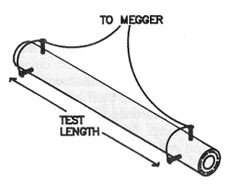
Test setup for determining electrical resistance.
Test Procedure
Conduct test as follows:
2. Assure that both inside & outside of hose are free of oil,dirt, etc.
3. Pierce sample ends with clean nails, as shown.
4. Connect nails to 1000 volt DC power source & megohm meter or 1000 volt "megger," as shown.
5. Record total resistance, in megohms.
6. Measure "test length" as shown.
7. Divide total resistance by test length to get megohms per inch.

